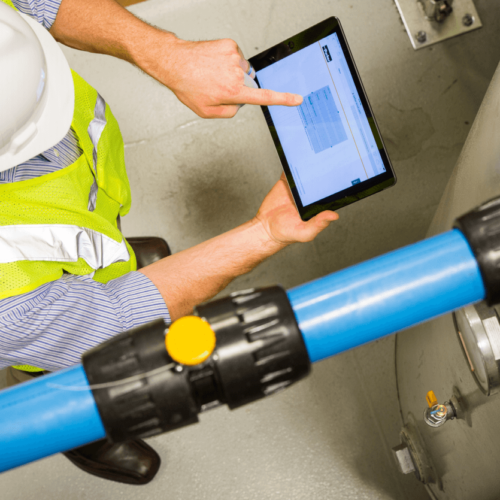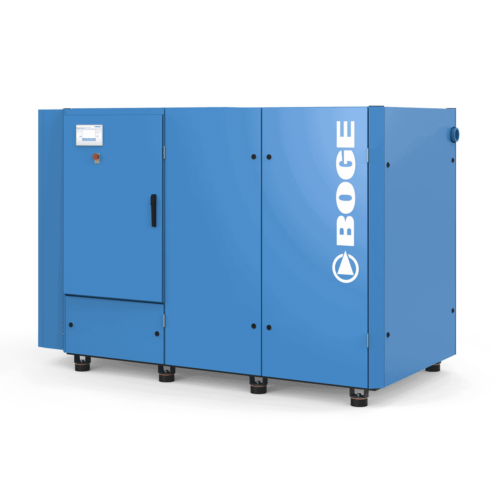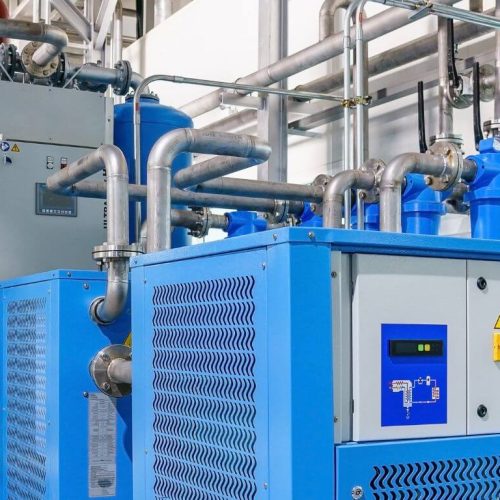Compressed air piping systems are essential in various industrial applications, facilitating the efficient and safe distribution of compressed air throughout facilities. These systems are crucial for powering many air tools and equipment, ensuring that operations are carried out smoothly. This guide will delve into the intricacies of compressed air pipe systems, discussing their functionality, material choices, sizing, common installation challenges, and maintenance practices to ensure optimal performance.
What is a Compressed Air Piping System?
How does a compressed air pipe system work?
A compressed air pipe system operates as a network designed to transport compressed air from the air compressor to the point of use. The system typically includes a series of compressed air pipes, fittings, and control valves that ensure the air flows efficiently and with minimal pressure drop. The compressor generates the air pressure required, which is then maintained and distributed through the air piping system. Proper design and installation are critical to prevent pressure loss and ensure the air reaches its destination with the necessary force.
What are the components of an air piping system?
The primary components of a compressed air piping system include the air compressor, filtration, air lines, fittings, and valves. Additionally, various piping materials such as aluminium and stainless steel pipe are used to construct the network. The compressor acts as the heart of the system, producing the necessary air pressure, while the pipes and fittings guide the flow to different facility sections. Valves are strategically placed to control the direction and pressure of the air, ensuring efficient distribution and usage.
Why is a compressed air system essential for industrial applications?
A compressed air system is indispensable in industrial settings due to its versatility and ability to power various air tools and machinery. These systems are designed to provide a reliable source of energy that is both flexible and easy to control. Manufacturing, automotive, and construction industries rely on compressed air networks to maintain productivity and efficiency. The ability to power equipment without electrical connections also enhances workplace safety and reduces the risk of electrical hazards.
What Materials are Used in Compressed Air Pipe Systems?
Which piping materials are most commonly used?
The choice of piping material is crucial for the efficiency and longevity of a compressed air piping system. Common materials include aluminium, HDPE, and galvanised steel, each offering unique benefits. Aluminium compressed air piping is known for being lightweight, non-corrosive, and easy to install, making it a popular choice for many industrial applications. Aluminium pipes are also widely used for their durability and resistance to corrosion, while HPDE pipes are often selected for their cost-effectiveness.
How does the choice of material affect airflow and pressure drop?
The material of the pipes significantly impacts the airflow and pressure drop within the system. Aluminium and other non-corrosive materials generally provide smoother internal surfaces, reducing friction and minimising pressure drop. This ensures the compressed air arrives at its destination with the necessary force and efficiency. Conversely, materials prone to corrosion or rust, such as untreated steel, can lead to rough internal surfaces, increasing pressure drop and reducing system efficiency over their lifetime. This leads to a very significant loss of energy and returns in extra cost over the life of the pipework.
What are the benefits of using corrosion-resistant piping?
Using corrosion-resistant piping, such as aluminium or stainless steel, offers numerous advantages. These materials help maintain the quality of the compressed air by preventing the introduction of rust and other contaminants. This protects the air tools and machinery, ensures consistent performance, and reduces maintenance costs. Corrosion-resistant pipes also have a longer lifespan, reducing the need for frequent replacements and guaranteeing a reliable compressed air distribution system.
How to Choose the Right Compressed Air Pipe Size?
Why is sizing important for an efficient air system?
Correct sizing is critical for the efficiency of a compressed air system. Proper sizing ensures the system can deliver the required air volume without significant pressure loss. Undersized pipes can lead to increased pressure drop and reduced performance, while oversized pipes can incur unnecessary costs and inefficiencies. Therefore, selecting the correct pipe diameter is essential for maintaining optimal airflow and system efficiency.
How do you calculate the correct pipe diameter for your needs?
Calculating the correct pipe diameter involves considering several factors, including the required air flow rate, the length of the piping system, and the acceptable pressure drop. Understanding the specific demands of your air tools and the layout of your facility will help you choose the most efficient and cost-effective piping solution.
What factors influence the size of compressed air piping?
Several factors influence the size of compressed air piping, including the type of air compressor used, the distance the air needs to travel, and the number of bends and fittings in the system. Longer distances and numerous turns can contribute to pressure loss, necessitating larger diameters to compensate. Additionally, the anticipated demand from air tools and the potential for future expansion should be considered to ensure the piping system remains effective and adaptable. As a result, while oversizing airlines will lead to increased initial capital expenditure, it has favorable outcomes such as acting as a reservoir for air, reducing the load on the compressor, and accommodating future demand.
What are Common Installation Challenges in Compressed Air Pipework?
How can pressure loss and leaks in air lines be prevented?
Preventing pressure loss and leaks in air lines requires meticulous installation practices and the use of quality materials. Ensuring that all fittings and connections are properly sealed and secured is paramount. Regular maintenance checks help identify potential leaks early, allowing for timely repairs. Additionally, choosing the best compressed air piping materials, such as those resistant to corrosion and rust, can prevent degradation that leads to leaks.
What are the best practices for installing air compressors and fittings?
Best practices for installing air compressors and fittings include selecting locations that minimise distance and bends in the piping system. Ensuring that compressors are installed on stable surfaces and fitted with appropriate vibration dampers can reduce wear and tear. Proper alignment of pipes and fittings, along with the use of high-quality, compatible components, is crucial to prevent leaks and maintain system integrity.
How do we address bends and turns in air pipe installation?
Bends and turns in air pipe installations can pose significant challenges, increasing the risk of pressure loss and reducing airflow efficiency. To address these issues, it is essential to use smooth, wide-radius bends and minimise the number of turns wherever possible. Using fittings designed for minimal resistance can help maintain airflow when installing bends. Proper planning and layout design are critical to overcoming these challenges and ensuring a well-functioning air piping system.
How to Maintain Quality in Compressed Air Piping Systems?
What maintenance practices ensure high-quality compressed air?
Maintaining high-quality compressed air involves regular inspection and cleaning of the air piping system to prevent the accumulation of debris and contaminants. Ensuring that filters and dryers function correctly helps remove moisture and impurities from the air supply. Scheduled maintenance checks can identify potential issues, such as leaks or blockages, allowing for timely interventions to maintain consistent air quality and system performance.
How to prevent rust and corrosion in air pipes?
Preventing rust and corrosion in air pipes is vital for maintaining the integrity and efficiency of the compressed air system. Using corrosion-resistant piping materials, such as aluminium or stainless steel, is a proactive measure. Applying protective coatings and ensuring that the system is free from moisture and contaminants further extends the lifespan of the pipes. Regular inspections can help detect early signs of corrosion, enabling preventive maintenance before significant damage occurs.
What role do air velocity and pressure play in system maintenance?
Air velocity and pressure play crucial roles in the maintenance and performance of compressed air piping systems. Maintaining optimal pressure levels ensures that air tools and machinery receive the necessary power to function efficiently. Excessive air velocity can cause wear and increase the risk of leaks, while insufficient pressure can lead to inadequate tool performance. Regular monitoring and adjustment of these parameters are essential for the long-term success of the air compression system.
What are the best materials for pipes for compressed air systems?
Due to their corrosion resistance and durability, the best materials for pipes for compressed air systems include aluminium, copper, stainless steel and certain plastics like polyethylene (PE100). PVC pipe is unsuitable for compressed air applications as it can shatter under pressure.
Why is quality compressed air piping important for air tools?
Quality compressed air piping ensures efficient air flow, maintains consistent pressure, and reduces the risk of leaks, all of which are critical for the optimal performance of air tools.
Can I use plastic pipes for my compressed air line?
Plastic pipes, such as those made from PE100 polyethylene, are suitable for compressed air lines due to their flexibility and corrosion resistance. However, not all plastic pipes are safe, so it’s essential to choose materials specifically designed for compressed air use. Never use PVC for compressed air pipework. While using plastic pipes and fittings, ensure they have good fire retard properties and are fire rated.
What role do air fittings play in a compressed air pipe system?
Air fittings are crucial components in a compressed air pipe system. They connect different piping sections, hoses, and tools, ensuring a secure and leak-free system that maintains air pressure and quality.
How can compressor oils impact my compressed air system?
Compressor oils are essential for the lubrication and cooling of air compressors, but they must be carefully managed to prevent contamination of the air stream. Using proper air compressor filters can help maintain quality air by removing oil and other particulates. Certain oil types can also react with seals, so filtration becomes even more important.
How should I maintain my compressed air line to ensure longevity?
Regularly maintaining your compressed air line involves checking for leaks, ensuring fittings are secure, cleaning filters, and inspecting hoses for wear. Using corrosion-resistant materials and consulting air pipe specialists can also help extend the system’s life.
Who should I contact if I need help with designing a compressed air system?
For assistance with designing a compressed air system, it is best to contact us at Cleveland Compressors, air pipe specialists who can provide expert guidance and customised solutions to meet your specific needs.



